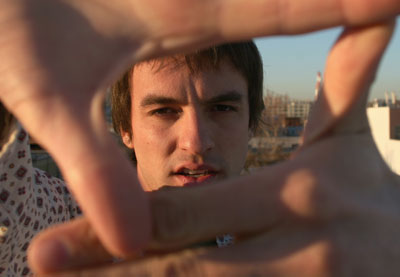STILL LIFE
A FILMMAKER WRITES ABOUT HOW HE MADE BETWEEN YOU AND ME, A COMPELLING SHORT ABOUT NEW YORK CHANCE ENCOUNTERS, WITH A CANON STILL CAMERA.
BY PATRYK REBISZ
 | |
| Rasko Ristic in Patryk Rebisz’s Between You and Me. | |
Like many of my projects, this one was born of frustration. My writing partner and I couldn’t find the money for our low-budget road-trip short, and somehow our relationship was faltering too. So I needed a new project that could be shot for no money and with no dialogue. In the back of my mind I had been playing around with the idea of a short film that would be shot with the burst mode of a still digital camera. But the story would have to have a reason to be shot that way. It couldn’t be just a gimmick.
I came up with a simple boy-meets-girl idea: A girl on her day off jogs through the streets of New York, taking photographs of stuff along the way. She’s assaulted in the evening and loses the camera. The “good guy” who tried to save her from the mugging finds the camera, and it becomes his only clue as to where she might live.
With the story set, I spent two days looking for proper locations — streets with interesting lighting, color and space. And I needed a camera that could shoot lots of pictures at a time. A friend recently bought the Canon EOS 20D. I tried its burst mode and was in seventh heaven. In this mode we could record at five frames per second (as opposed to film’s 24). We could shoot for about 12 seconds before the camera’s memory buffer would fill up, so our takes had to be really exact — no long, hypnotic shots. I did a series of tests beforehand to find the best setup and learned, for instance, that the 3200 ISO “artificial H setting” introduces a very weird kind of grain with horizontal lines. That was okay with me because the film was intended to be viewed on a standard-resolution TV screen, so those lines wouldn’t be visible. While shooting I often had to open up the shutter, which created lots of “strobiness,” but again, that was fine by me.
We started shooting on Sunday. I was quite unhappy. I suppose I didn’t have a clear vision of what the actress was supposed to be doing during her run. Moreover she decided to go against my suggestions and wear all-black — something that would cause trouble for night exteriors. I knew I would have to reshoot. I had way too many wide shots where the runner got lost in the frame. I was about to give up, and then one night I watched one of those stupid reality shows, one where Donald Trump was saying, “There’s no such thing as failure.” So I decided to continue.
We went out again, and it got easier. The actor who wasn’t in the shot would hold a small light with some kind of diffusion or a gel (blue, yellow, green). We would shoot until the camera’s memory card filled up (1 GB — about 650 stills), and then we would take a break to transfer the pictures to our laptop. We would walk around the neighborhood waiting for one of the cast to get out of work, and we would shoot random scenes of the girl walking at night whenever the light in an area was interesting. It gave us a feeling of great freedom. We weren’t dependent on anyone but ourselves.
While shooting, the actors said they should have seen each other before, earlier in the film. That way when they meet again at the end the circle would be complete. I thought about it, the light was good, and 20 minutes later we had our opening scene in the can.
During the editing process, I had to figure out how much to slow down the footage. At normal speed — 24 frames per second — the clips played about four to five times faster than in real life. I didn’t want the stills to play at that speed as it would imply a movie with many frames missing in between. I decided that the footage should play at half regular speed. At this speed it looks like a mirage, something not fully real, and thus maybe the viewer will be less annoyed at the lack of information produced by the frame rate.
Worrying that people would assume that the film is missing frames or, if they saw it on the Internet, that the film is playing at a slow frame rate due to Web compression, I chose a “clicker” effect as a background sound to right away signify the fact that we are watching a series of photographs.
Making Between You and Me was a very rewarding experience, and the clip became quite popular online. In just a few days it was seen by almost 35,000 people.
See Between You and Me at http://patrykrebisz.com/stills/FINAL_movie.html.
VOD CALENDAR


 See the VOD Calendar →
See the VOD Calendar →


